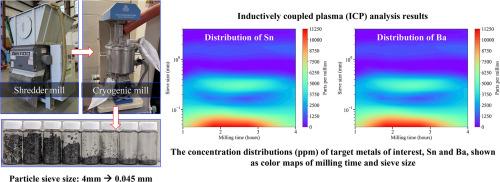从低品位混合废印刷电路板中回收有价金属的潜力:从机械预处理的角度
IF 7.1
Q1 ENGINEERING, CHEMICAL
引用次数: 0
摘要
为了从电子废物(电子废物)中回收有价值的金属,工业界更喜欢按类别分类的原料流,以提高效率。但这忽略了大量的混合废弃印刷电路板(wpcb),它们碎片化,难以分离,并继续对环境和人类健康构成风险。本研究从机械预处理的角度探讨了从丰富的低品位混合wpcb中回收有价金属的潜力。介绍了一种包括粉碎和低温碾磨的两阶段粉碎过程,并采用两阶段元素组成分析方法来研究精选有价金属的浓度。低温磨机经过特殊配置,可最大限度地减少空气中的粉尘,确保安全的实验室环境,并实现99%以上的质量保留。研磨后的颗粒依次从4到0.045 mm进行筛选,以准确分析每种尺寸级中的金属浓度。铜在质量百分比上占主导地位,并且在较大的颗粒中集中,其次是铝。钡的浓度随粒径的增大而增大,从4 ~ 0.045 mm,而锡的浓度在0.5 mm左右达到峰值。铍几乎是检测不到的。粉碎pcb的最佳研磨时间取决于目标金属。我们的研究结果表明,有可能从低品位的混合wpcb中以不同的粒径回收目标金属,即,较大的颗粒用于铜等贱金属,较小的颗粒用于钡和锡等高价值金属。在较小的颗粒中发现铅浓度较高,突出了提出的磨粉过程中的细粒遏制方法的必要性。本文章由计算机程序翻译,如有差异,请以英文原文为准。

The potential of valuable metal recovery from low-grade mixed waste printed circuit boards: Perspectives from mechanical preprocessing
To recover valuable metals from electronic waste (e-waste), industry prefers feedstock streams by category to improve efficiency. This though ignores the massive mixed waste printed circuit board (WPCBs) that are fragmented, hard to separate, and continue presenting risks to the environment and human health. This work explores the potential of valuable metal recovery from the abundant low-grade mixed WPCBs with perspectives from mechanical preprocessing. A two-stage comminution process involving shredding and cryogenic milling, with a two-stage elemental composition analysis method, is introduced to investigate the concentrations of select valuable metals. The cryogenic mill is specially configured to minimize airborne fines, ensure safe laboratory environment, and achieve over 99 % mass retention. The milled particles are screened successively from 4 to 0.045 mm for accurate analysis of metal concentrations in each size class. Copper is dominant regarding mass percentage and concentrated in larger particles, followed by aluminum. The concentration of barium grows consistently with particle size decreasing from 4 to 0.045 mm, while tin exhibits a peak concentration around 0.5 mm. Beryllium is nearly non-detectable. Optimal milling time for the shredded PCBs depends on the target metals. Our findings indicate a potential to recover target metals from the low-grade mixed WPCBs in separate particle sizes, i.e., larger particles for base metals like copper and smaller particles for higher-value metals like barium and tin. Lead concentration is found higher in smaller particles, highlights the necessity of the proposed fines containment method for milling process.
求助全文
通过发布文献求助,成功后即可免费获取论文全文。
去求助
来源期刊

Chemical Engineering Journal Advances
Engineering-Industrial and Manufacturing Engineering
CiteScore
8.30
自引率
0.00%
发文量
213
审稿时长
26 days
 求助内容:
求助内容: 应助结果提醒方式:
应助结果提醒方式:


